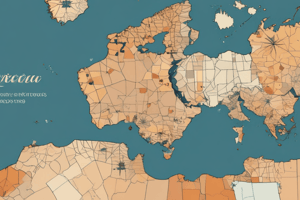Podcast
Questions and Answers
What was one of the primary goals of the EU-UK Trade and Cooperation Agreement?
What was one of the primary goals of the EU-UK Trade and Cooperation Agreement?
- To eliminate all trade tariffs between the EU and UK
- To establish extensive direct trade routes
- To create a customs union between EU and UK
- To minimize trade barriers post-Brexit (correct)
What is the expected outcome of the African Continental Free Trade Area (AfCFTA)?
What is the expected outcome of the African Continental Free Trade Area (AfCFTA)?
- Enhancement of intra-African trade (correct)
- Promotion of bilateral agreements exclusively
- Increase in tariffs across African nations
- Isolation of African economies from global markets
Which statement accurately describes the impact of the UK-Australia Free Trade Agreement?
Which statement accurately describes the impact of the UK-Australia Free Trade Agreement?
- It decreases trade relationships with other Commonwealth countries
- It improves access for services while reducing tariffs on goods (correct)
- It primarily focuses on increasing tariffs on Australian goods
- It creates a customs bloc for both countries
What category of trade agreements does NOT fall under the common classifications mentioned?
What category of trade agreements does NOT fall under the common classifications mentioned?
Which of the following statements reflects a challenge faced by businesses due to the EU-UK Trade Agreement?
Which of the following statements reflects a challenge faced by businesses due to the EU-UK Trade Agreement?
What is the primary purpose of bilateral trade agreements?
What is the primary purpose of bilateral trade agreements?
Which of the following describes a multilateral trade agreement?
Which of the following describes a multilateral trade agreement?
What does the most-favored-nation (MFN) clause pertain to?
What does the most-favored-nation (MFN) clause pertain to?
Which benefit of trade agreements is most related to reducing consumer prices?
Which benefit of trade agreements is most related to reducing consumer prices?
What is a significant challenge posed by regulatory compliance in trade agreements?
What is a significant challenge posed by regulatory compliance in trade agreements?
What was a primary goal of the USMCA compared to NAFTA?
What was a primary goal of the USMCA compared to NAFTA?
What is a key impact of the RCEP trade agreement?
What is a key impact of the RCEP trade agreement?
Which aspect of trade agreements encourages businesses to explore new markets?
Which aspect of trade agreements encourages businesses to explore new markets?
What is the primary purpose of a trade agreement?
What is the primary purpose of a trade agreement?
Which of the following is a benefit of trade agreements?
Which of the following is a benefit of trade agreements?
What can trade agreements significantly reduce for cross-border trades?
What can trade agreements significantly reduce for cross-border trades?
Which organization is primarily responsible for overseeing international trade agreements?
Which organization is primarily responsible for overseeing international trade agreements?
What is meant by 'preferential treatment' in the context of trade agreements?
What is meant by 'preferential treatment' in the context of trade agreements?
Which of the following illustrates an example of a unilateral trade agreement?
Which of the following illustrates an example of a unilateral trade agreement?
How have trade agreements contributed to economic growth since the 1950s?
How have trade agreements contributed to economic growth since the 1950s?
What is one way trade agreements enhance the standard of living?
What is one way trade agreements enhance the standard of living?
Flashcards are hidden until you start studying
Study Notes
Trade Agreements Overview
- Trade agreements are negotiations between countries that establish terms for trade, including tariffs, quotas, and provisions like intellectual property rights.
- They allow cross-border ecommerce retailers to access larger markets, enhancing sales opportunities.
- Benefits of trade agreements include reducing geopolitical barriers, encouraging investments, improving economies, creating jobs, increasing variety of goods, and enhancing standards of living.
Impact of Trade Agreements
- Membership in trade agreements boosts trade among countries by employing benefits that stimulate economic growth and strengthen international relationships.
- Agreements often provide preferential treatment to certain products, such as lower or zero tariffs based on product types and country of origin, reducing import costs.
Types of Trade Agreements
- Three main types of trade agreements:
- Unilateral: Non-reciprocal trade preferences from developed to developing countries, such as SPARTECA.
- Bilateral: Agreements between two countries promoting mutual economic benefits, exemplified by the EU-Japan Economic Partnership Agreement.
- Multilateral: Agreements among three or more countries facilitating simpler trade processes, like WTO members adhering to the most-favored-nation clause.
Specific Categories of Trade Agreements
- Regional Trade Agreements (RTAs): Agreements among countries in a defined geographic area (e.g., EU, ASEAN).
- Free Trade Agreements (FTAs): Focus on reducing or eliminating tariffs and trade barriers between member countries.
- Customs Unions: Adopt a shared external tariff on imports from non-member nations.
Benefits of Trade Agreements
- Increased trade stimulates economic growth by broadening exporters' markets.
- Cost savings for consumers and businesses from reduced prices.
- Encouragement for businesses to explore and invest in new markets.
Challenges Faced by Trade Agreements
- Economic disparities often cause larger economies to benefit disproportionately compared to smaller nations.
- Navigational difficulties due to varying regulatory compliance across countries.
- Political changes can influence the stability and effectiveness of trade agreements.
Recent Trade Agreements and Their Effects
- USMCA (2020): Replaces NAFTA, strengthens trade between the U.S., Canada, and Mexico.
- RCEP (2020): Largest trade agreement by population, promoting economic integration among 15 Asia-Pacific countries.
- EU-UK Trade and Cooperation Agreement (2021): Governs post-Brexit trade relations, leading to increased administrative burdens.
- UK-Australia Free Trade Agreement (2021): Enhances trade and investment, marking the UK's post-Brexit efforts to establish new trade ties.
- AfCFTA (2021): Aims to unify trade across 54 African countries, targeting tariff reduction and non-tariff barrier elimination to boost intra-African trade.
Categories of Trade Agreement Categories
- Includes regional trade agreements, bilateral investment treaties, WTO agreements, suspension agreements, and intellectual property agreements.
- These categories can be unilateral, bilateral, or multilateral in nature.
Studying That Suits You
Use AI to generate personalized quizzes and flashcards to suit your learning preferences.




